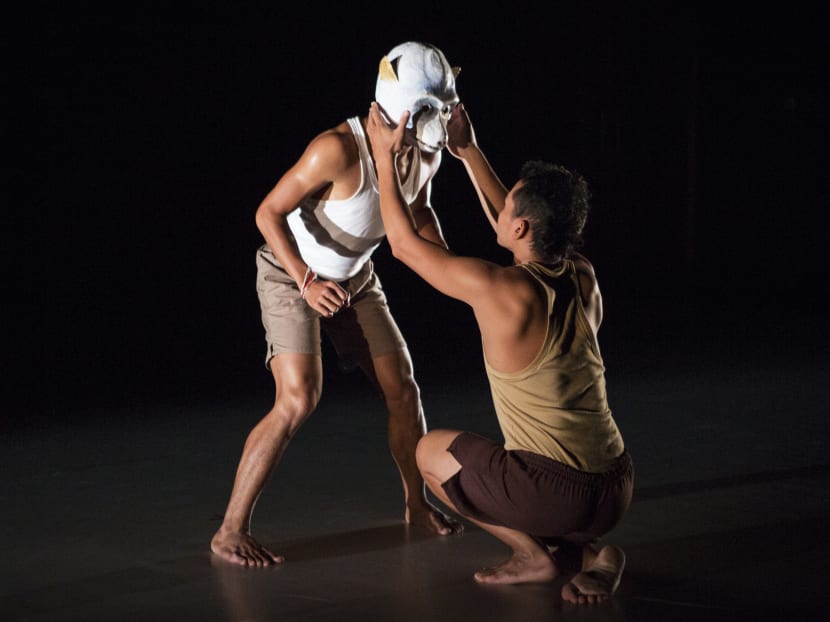da:ns Fest 2013: Going ape in Khmeropedies III: Source/Primate
SINGAPORE — What is it with monkeys and dance? SeptFest had one about gorillas, now da:ns Fest has Khmeropedies III: Source/Primate.

Emmanuele Phuon and Amrita Performing Arts' Khmeropedies III: Source/Primate. Photo: Yi-Chun Wu/Esplanade.
SINGAPORE — What is it with monkeys and dance? SeptFest had one about gorillas, now da:ns Fest has Khmeropedies III: Source/Primate.
Actually, there’s also a link to last week’s we’re-warming-up-but-it’s-actually-the-show show by Ming Poon and Scarlet Yu — here’s another performance that strips down and interrogates performance.
French-Cambodian choreographer Emmanuel Phuon and Cambodian group Amrita Performing Arts craft a wonderful, energetic show based on monkey movements and behaviour — like how the folks back then created the traditional Khmer “monkey dance”. Except this time around, there’s more stuff to pick and choose from, like videos, scientific material and erm, zoos.
At the start, we’re given a frame of reference — two dancers mimicking monkey movements flanking a dancer performing elements of the traditional monkey dance. It’s brief but somewhat enough to get us into a “same same but different” mindset, before we plunge into the jungle, so to speak, without David Attenborough tagging along.
I’m slightly joking of course (and in no way being sarcastic — who doesn’t heart David Attenborough and documentaries?!) but the show *is* more about the monkey bit than the monkey dance bit.
I know more about (and see more) real monkey stuff on television than traditional Cambodian dance onstage (whether that’s tragic or not, I’m not sure) and with the relative absence of the latter, it’s not hard to read it as mainly about monkeys—especially if that’s what you see for the most part.
To some hypnotic, intricate wood/piano percussive sounds, the dancers artfully monkey around onstage — a series of scenes of them bounding around on all fours and exhibiting simian behaviour.
Some scenes are directly inspired by specific incidents, like an experiment in the `70s where monkeys interact with their own reflection, seen here as dancers mimicking each other. There are moments that touch on sex, death and territorial aggression (although it doesn’t quite reach the vicious heights of a band of chimps hunting down other monkeys and eating them — probably the most disturbing Attenborough docu episode I’ve ever seen).
There is variety, too, in the types of monkey behaviour. The group didn’t stick to one copying just one kind. This attention to difference brings me to my next point — while Khmeropedies III touches on commonality via a “source”, there is the unavoidable aspect in which it simultaneously and, perhaps, pointedly underscores difference.
The dancers mimicking monkeys is far from being natural — it’s physically regressive from an evolutionary standpoint, course. Everyone is aware of this. Once they step out of the boundaries that define the stage space, they immediately snap out of it. But then again, sometimes the distinction isn’t clear within that space, too. They’re obviously “doing” monkey but sometimes they’re in sync, sometimes they do something that’s obviously too clean to be mere animal gesture — choreography is in the mix.
The switches underscore the very nature of performance itself and so the idea of a “source” implodes. Here are classically trained dancers-as-monkeys-doing-something “contemporary” (or at least non-classical). The lines blur.
It’s all encapsulated in the fantastic finale. A “monkey”, who has died, is now convulsing and seemingly in the process of resurrection—and evolution—as he slowly starts to stand up on his hind legs.
To be honest, I was expecting it to be cheesy, as the part where the piece neatly links monkey and classical dance together. Instead, it turned out to be the clearest, most visceral elaboration of artistic transformation I have seen.
The dancer/monkey/man literally embodies the struggle (it certainly was no Cinderella moment, with the eerie chanting and the awkwardness of movement) and the whole moment acknowledges the unknown.
Because you never see the complete transformation, what you cling on to is the performance of it, and the layers involved — first, when a monkey mask is placed over the dancer’s face, and finally, when darkness engulfs the entire body.
In our eyes, the transformation will never be complete.
Khmeropedies III: Source/Primate continues tonight, Oct 16, 8pm, Esplanade Theatre Studio. Tickets from Sistic. http://www.dansfestival.com/2013/








